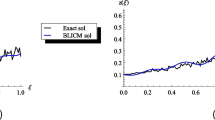Abstract
In this paper, we consider a class of stochastic mathematical programs with equilibrium constraints introduced by Birbil et al. (Math Oper Res 31:739–760, 2006). Firstly, by means of a Monte Carlo method, we obtain a nonsmooth discrete approximation of the original problem. Then, we propose a smoothing method together with a penalty technique to get a standard nonlinear programming problem. Some convergence results are established. Moreover, since quasi-Monte Carlo methods are generally faster than Monte Carlo methods, we discuss a quasi-Monte Carlo sampling approach as well. Furthermore, we give an example in economics to illustrate the model and show some numerical results with this example.
Similar content being viewed by others
References
Birbil SI, Gürkan G and Listes O (2006). Solving stochastic mathematical programs with complementarity constraints using simulation. Math Oper Res 31: 739–760
Birge JR and Louveaux F (1997). Introduction to stochastic programming. Springer, New York
Chen Y and Florian M (1995). The nonlinear bilevel programming problem: formulations, regularity and optimality conditions. Optimization 32: 193–209
Fukushima M, Lin GH (2004) Smoothing methods for mathematical programs with equilibrium constraints. Proceedings of the ICKS’04. IEEE Computer Society, New York, pp 206–213
Fukushima M, Pang JS (1999) Convergence of a smoothing continuation method for mathematical problems with complementarity constraints, illposed variational problems and regularization techniques. In: Théra M, Tichatschke R (eds) Lecture Notes in Economics and Mathematical Systems, vol 477. Springer, Heidelberg, pp 105–116
Hall P and Marron JS (1991). Local minima in cross-validation functions. J Roy Stat Soc Ser B 53: 245–252
Jiang H and Ralph D (2000). Smooth SQP methods for mathematical programs with nonlinear complementarity constraints. SIAM J Optim 10: 779–808
Lin GH and Fukushima M (2005a). A class of stochastic mathematical programs with complementarity constraints: Reformulations and algorithms. J Ind Manage Optim 1: 99–122
Lin GH and Fukushima M (2005b). Regularization method for stochastic mathematical programs with complementarity constraints. Eur Ser Appl Ind Math (ESAIM): Control Optim Calculus Variations 11: 252–265
Lin GH, Chen X, Fukushima M (2003) Smoothing implicit programming approaches for stochastic mathematical programs with linear complementarity constraints. Technical Report 2003–2006, Department of Applied Mathematics and Physics, Graduate School of Informatics, Kyoto University, Kyoto, Japan
Lin GH, Chen X, Fukushima M (2007) Solving stochastic mathematical programs with equilibrium constraints via approximation and smoothing implicit programming with penalization. Math Program (to appear)
Luo ZQ, Pang JS and Ralph D (1996). Mathematical programs with equilibrium constraints. Cambridge University Press, Cambridge
Niederreiter H (1992) Random number generation and Quasi-Monte Carlo methods. SIAM, Philadelphia
Ortega JM and Rheinboldt WC (1970). Iterative solution of nonlinear equations in several variables. Academic Press, New York
Scheel H and Scholtes S (2000). Mathematical programs with complementarity constraints: stationarity, optimality and sensivity. Math Oper Res 25: 1–22
Shapiro A (2003). Monte Carlo sampling approach to stochastic programming. Eur Ser Appl Ind Math (ESAIM): Proc 13: 65–73
Shapiro A (2006). Stochastic mathematical programs with equilibrium constraints. J Optim Theory Appl 128: 223–243
Shapiro A, Xu H (2005) Stochastic mathematical programs with equilibrium constraints, modeling and sample average approximation. Preprint, School of Industrial and System Engineering, Georgia Institute of Technology, Atlanta
Xu H (2006). An implicit programming approach for a class of stochastic mathematical programs with linear complementarity constraints. SIAM J Optim 16: 670–696
Author information
Authors and Affiliations
Corresponding author
Additional information
The first author’s work was supported in part by the Scientific Research Grant-in-Aid from Japan Society for the Promotion of Science and SRF for ROCS, SEM. The second author’s work was supported in part by the United Kingdom Engineering and Physical Sciences Research Council grant. The third author’s work was supported in part by the Scientific Research Grant-in-Aid from Japan Society for the Promotion of Science.
Rights and permissions
About this article
Cite this article
Lin, GH., Xu, H. & Fukushima, M. Monte Carlo and quasi-Monte Carlo sampling methods for a class of stochastic mathematical programs with equilibrium constraints. Math Meth Oper Res 67, 423–441 (2008). https://doi.org/10.1007/s00186-007-0201-x
Published:
Issue Date:
DOI: https://doi.org/10.1007/s00186-007-0201-x
Keywords
- Stochastic mathematical program with equilibrium constraints
- Monte Carlo/quasi-Monte Carlo methods
- Penalization




